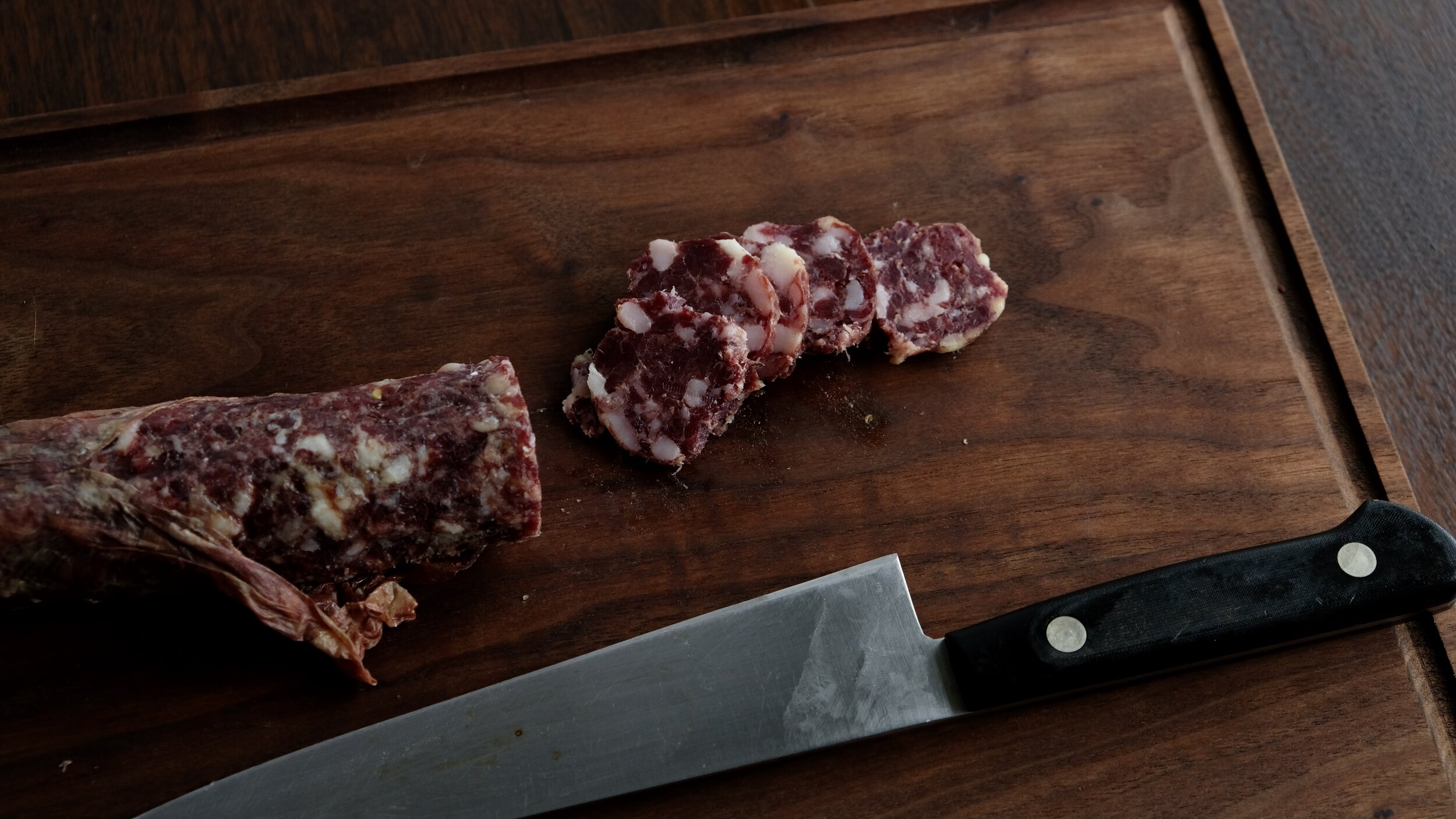Venison Coppa Salami

I got this idea from my go to book on cured meats, Charcuterie by Ruhlman & Polcyn. In that book, they describe a coppa, (aka capocollo, or capicola) made from chunks of pork shoulder and pork fat to simulate the muscle traditionally used to make this Italian charcuterie. This gave me the idea to do something similar with venison and pork fat.
The idea of fusing together large pieces of pork fat and venison was intriguing. The concept sounded wildly different from any other charcuterie I've made, but after reading through the process, I realized that at its core, this wouldn’t be much different from making a salami.
There are, of course, a few key steps to make this work. The recipe is a blend between a cured whole muscle and a salami. Large pieces of pork fat and venison are cured and stuffed into a large natural casing. This recipe uses cure #2 like all our salamis, but does not call for a starter culture.
The meat has to be worked for an extended period of time before stuffing into the casing. This allows myosin protein to become available, which is what will fuse the meat and fat together. In most of our salami recipes, the meat will become tacky after just a few minutes in a stand mixer with a paddle attachment. These larger pieces of meat will require extra time and the use of a dough hook.
The meat has to be fused together for two main reasons- first, appearance and texture. The idea is to make these chunks of meat similar to a whole muscle. If the meat is not fused together, it’ll just fall apart when sliced. Secondly, and most importantly, without proper fusion there is the potential for air bubbles between the pieces of meat and fat. This could lead to spoilage, inconsistent drying, or worse; serious food borne illness such as botulism.
All that being said, if you can make salami, you can make this coppa. The core concept is the same- work cold and work clean, let salt and time do their magic.
This coppa hung for about a month and half before losing 35% of its weight. It had great coverage from the mold 600 and felt consistent throughout, but just to play it extra safe, I vacuum sealed it and let it equalise for 60 days.
Cutting into this coppa exposed a thing of beauty. It is honestly one of the coolest things I've ever made. The texture is perfect, the venison flavor is pronounced and highlighted by the spices, and the silky fat contrasts the meat perfectly. But namely, it's just so cool that you can take pieces of fat and deer meat and make it into a seamless charcuterie with just salt and time.
Charcuterie making has always amazed me, but it seems that the more I understand about it, the more I realize how simple it is, and that in itself is amazing. This is an age-old process that is still intact today, a necessity that has evolved into a craft that borders on art. As improved as the process has gotten with technology, at the end of the day, it still comes down to salt, time, and high quality meat.
Venison Coppa Recipe
As always, we use metric measurements and go by percentage weight for our sausage recipes. We do this to make the recipes easy to scale and replicate exactly, batch after batch. If you’re thinking of getting into sausage making and don’t own a kitchen scale, please do yourself the favor of buying one. They’re inexpensive relative to the cash outlay of all the other equipment you’ll need to pick up, and will save you a lot of effort in terms of scaling recipes into imperial measurements. To measure your ingredients, first weigh the meat you are using, and then calculate the weight of all the other ingredients based on the weight of the meat.
This recipe calls for large natural casings, we used 102-115mm (4”) beef bungs, but you could use large beef middles.
Prep time: 30 minutes
Ingredients:
Venison top round and pork fat cut into ~3”X1” strips (7:3 ratio)
3% salt
0.25% instacure #2
1% dextrose
1.5% hot paprika
0.5% cayenne
Method:
Cut your meat and fat into 3”x1” strips. You want approximately a 7:3 ratio of meat to fat. Weigh the meat and fat- use that weight in grams to calculate the amount of the other ingredients.
Combine meat, salt, cure #2 and dextrose in a large container. Use your hands to mix until evenly coated. Place in a vacuum bag and seal. Refrigerate for a week, flipping daily to redistribute moisture.
Remove meat from bag and rinse with cold water and pat dry. Cover with paprika and cayenne. Mix vigorously by hand until meat becomes sticky, 6-10 minutes. Alternatively, you can mix the meat and fat in a stand mixer with a dough hook on the lowest setting. Either way, the meat should be sticky and have a pasty look to its exterior.
Stuff by hand into large beef middles or small beef bung. Pack as tight as possible, you want to eliminate any air pockets between the meat. Prick with a sterile needle to deflate any visible air pockets.
Tie up ends or use hog rings. Prick with a sterilized needle. Weigh and record weight.
Move coppa to cure chamber, hang until 30-35% weight loss. 30-60 days.


































